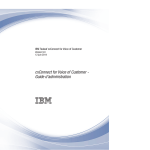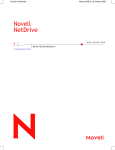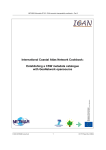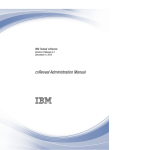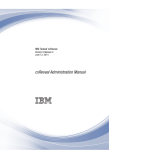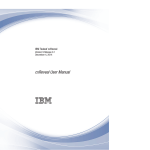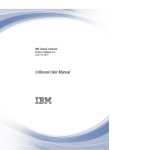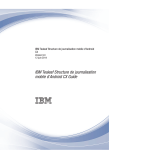Download IBM Tealeaf cxReveal: cxReveal API Guide
Transcript
IBM Tealeaf cxReveal
Version 9 Release 0.1
December 4, 2014
cxReveal API Guide
Note
Before using this information and the product it supports, read the information in “Notices” on page 15.
This edition applies to version 9, release 0, modification 1 of IBM Tealeaf cxReveal and to all subsequent releases
and modifications until otherwise indicated in new editions.
© Copyright IBM Corporation 1999, 2014.
US Government Users Restricted Rights – Use, duplication or disclosure restricted by GSA ADP Schedule Contract
with IBM Corp.
Contents
Chapter 1. cxReveal API Guide . . . . . 1
Submitting A Pre-Configured Search
Session Search . . . . . . .
Populating a Search Template. . .
Search Template Fields . . . .
Chapter 2. Configuration
Overview . . . . .
WSDL . . . . .
API Methods . . .
Using the API . . . .
StartSearch method .
StartDbSearch method
.
.
.
.
.
.
.
.
.
.
.
.
© Copyright IBM Corp. 1999, 2014
.
.
.
.
.
.
.
.
.
.
.
.
.
.
.
.
.
.
.
.
.
.
.
.
1
1
2
2
. . . . . . . 5
.
.
.
.
.
.
.
.
.
.
.
.
.
.
.
.
.
.
.
.
.
.
.
.
.
.
.
.
.
.
.
.
.
.
.
.
.
.
.
.
.
.
.
.
.
.
.
.
5
5
5
6
6
7
GetSearchStatus method . .
GetSearchResults method . .
GetSessionPagesList method .
GetSessionAnnotations method
Example Code . . . . . . .
.
.
.
.
.
.
.
.
.
.
.
.
.
.
.
.
.
.
.
.
.
.
.
.
.
.
.
.
.
.
.
.
.
.
.
8
8
9
9
9
Chapter 3. IBM Tealeaf documentation
and help . . . . . . . . . . . . . . 13
Notices . . . . . . . . . . . . . . 15
Trademarks . . . . . . .
Privacy Policy Considerations .
.
.
.
.
.
.
.
.
.
.
.
.
. 17
. 17
iii
iv
IBM Tealeaf cxReveal: cxReveal API Guide
Chapter 1. cxReveal API Guide
The IBM Tealeaf cxReveal API Guide provides an overview of the application-level
interfaces provided by IBM Tealeaf cxReveal. Use the links below to access specific
topics in the manual.
Submitting A Pre-Configured Search
Note: When NT authentication is in use on IIS7, you must disable Forms
Authentication (HTTP 302 Login/Redirect) on IIS Authentication for the Portal site.
See "Authentication" in the IBM Tealeaf cxImpact Administration Manual.
Session Search
Session search queries are passed to Search Server for execution against the
appropriate canisters to retrieve sessions.
v For more information on the Portal-based version of session search, see
"Searching Session Data" in the IBM Tealeaf cxImpact User Manual.
Overview
All parameters must be URL-encoded.
All arguments are optional, but nothing will happen if you don't provide either an
active query or an archive query. Providing both will perform an All Sessions
search using both.
Argument
Value
activequery
The active search query to perform. There is no validation, and it is sent
directly to search server as a query.
archivequery
The archive search query to perform.
datespan
The numeric constant representing the dates to search on. Accepted values:
v 0 - All
v 1 - Only Today
v 2 - Only Yesterday
v 3 - Last 2 Days
v 4 - Last 7 Days
v 5 - Last 14 Days
v 6 - Last 28 Days
v 7 - Last 6 Hours
v 8 - Last 12 Hours
v 9 - Last 24 Hours
v 10 - last hour
v 11 - Latest 5 minutes
v 12 - Latest Hour
© Copyright IBM Corp. 1999, 2014
1
v -1 - Use Specified Dates and Times
startdate
If datespan is set to -1, this is the ISO-format date for the beginning date of
the range (e.g. 2007-01-02 is Jan 02, 2007)
enddate
If datespan is set to -1, this is the ISO-format date for the end date of the
range (e.g. 2007-01-02 is Jan 02, 2007)
starttime
If datespan is set to -1, this is the 6-digit, 24-hour time for the beginning of
the range, in HHMMss format (e.g. 003015 is 00:30:15 or 12:30:15 AM)
endtime
If datespan is set to -1, this is the 6-digit, 24-hour time for the end of the
range, in HHMMss format (e.g. 233059 is 23:30:59 or 11:30:59 PM)
scope
The scope of the search. Does not really apply since the query is already
built, if scope is set to 2 for an archive search, it will be and on same page
for the query. How the results will be sorted.
timeout
The maximum allotted time for an archive search, in seconds. The search
will be stopped once this amount of time has elapsed, but more time may
be required to collate the sessions found.
autostop
Specifies the limit at which an archive search will be stopped. When X
matching sessions are found, the search is stopped.
Examples
All parameters must be URL-encoded.
Since this mode goes directly to the search results there is no way for a user to
modify a search performed in this way.
Example
Search all text for tealeaf.
URL
SessionSearch.aspx?activequery=%28request_contains_tealeaf%29_OR
_%28response_contains_tealeaf%29&archivequery=%28tealeaf%29
Active query: (request contains tealeaf) OR (response contains tealeaf)
Archive query: (tealeaf)
Populating a Search Template
See "Configuring Search Templates" in the IBM Tealeaf cxImpact Administration
Manual.
Search Template Fields
Field
Value
template
1 - <Default Active>
2 - <Default Archive> (Standard mode)
2
IBM Tealeaf cxReveal: cxReveal API Guide
3 - <Default Archive> (Extended mode)
4 - <Default All Sessions> (Standard mode)
5 - <Default All Sessions> (Extended mode)
datespan
0 - All
1 - Only Today
2 - Only Yesterday
3 - Last 2 Days
4 - Last 7 Days
5 - Last 14 Days
6 - Last 28 Days
7 - Last 6 Hours
8 - Last 12 Hours
9 - Last 24 Hours
10 - last hour
11 - Latest 5 minutes
12 - Latest Hour
-1 - Use Specified Dates and Times
startdate
If datespan is set to -1, this is the ISO-format date for the beginning date of
the range (e.g. 2007-01-02 is Jan 02, 2007)
enddate
If datespan is set to -1, this is the ISO-format date for the end date of the
range (e.g. 2007-01-02 is Jan 02, 2007)
starttime
If datespan is set to -1, this is the 6-digit, 24-hour time for the beginning of
the range, in HHMMss format (e.g. 003015 is 00:30:15 or 12:30:15 AM)
endtime
If datespan is set to -1, this is the 6-digit, 24-hour time for the end of the
range, in HHMMss format (e.g. 233059 is 23:30:15 or 11:30:59 PM)
scope
0 - AND
1 - OR
2 - AND On Same Page (all constraints appear on a single page)
timeout
0 - No Timeout
90
180
300
600
autostop
0 - No Limit
1000
5000
10000
20000
opX
1 - None
Note: If you have fewer than five specified search field arguments, the
operator for the non-specified parameters should be set to none.
Chapter 1. cxReveal API Guide
3
2
3
4
5
sort
-
Equals
Not Equals
Like
Not_Like
Active and All Sessions searches
0 - Num Hits
1 - Session Index
2 - Last Use (Time)
Completed searches
0 - Session score
1 - Application Errors
2 - Client Errors
3 - Server Errors
4 - Time Errors
5 - Size Errors
6 - Event Type
7 - not used
8 - IP Address
9 - Num Hits
10 - Num Requests
12 - Num Responses
13 - Random
14 - Session Index
15 - Text Pages
16 - UsrSts0
17 - UsrSts1
18 - First Use (Time)
19 - Last Use (Time)
20 - Canister Date
4
IBM Tealeaf cxReveal: cxReveal API Guide
Chapter 2. Configuration
When the Tealeaf Portal Application is installed into IIS, all necessary files to
enable the Web Services API are installed. To verify installation, navigate to the
following URL:
http://<portalmachine>/PortalAPI/cxReveal.asmx
If you receive a valid page the API is installed and available.
If not, you must create a PortalAPI virtual directory that maps to:
<TeaLeaf_install_directory>\Portal\WebService\
Note: It is the customer's responsibility to implement the Web Service logic.
Overview
Purpose: This API is intended to allow developers to integrate Tealeaf session
search/replay into a custom application. Regardless of the developer's knowledge
of the Tealeaf system, search is undoubtedly still untouched territory. In an attempt
to make this API usable by developers who may not be very familiar with the
Tealeaf system, the input/output of this API has been greatly simplified.
Supported Protocols: SOAP 1.1, SOAP 1.2, HTTP GET and HTTP POST
Requirements: Cookie support - most API functions require the API authentication
cookie to be present, if the client does not support cookies, the cookie will not be
preserved between requests.
The Web Service supports both REST and SOAP.
WSDL
If you're using a language that has a web service package that supports reading
from a WSDL, the Tealeaf Web Service enables you to retrieve the WSDL.
v A WSDL is an XML doc that describes the Web Service can do. Typically, your
web service package formulates the code API automatically for you.
The WSDL is available at:
http://hostname/PortalAPI/cxReveal.asmx?WSDL
API Methods
The API methods (this listing and further API specification are available by
navigating to:
http://hostname/PortalAPI/cxReveal.asmx
v Authenticate: Authenticate web service connection with a Portal username and
password. A null string is returned if successful, otherwise the error message is
returned.
v GetPageResponse: Returns the page content type and response, null on error.
v GetSearchEventsList: Returns a list of canister events available for searching,
null on error.
© Copyright IBM Corp. 1999, 2014
5
v GetSearchResults: Returns a list of session objects returned from the search, null
on error.
v GetSearchSortFields: Returns a list of TLSortField objects representing the
description/ID of acceptable search sort fields. Returns null on error.
v GetSearchStatus: Check the current status of a search. Only request results once
'Done' and 'DownloadComplete' are both true. Returns null on error.
v GetSessionAnnotations: Retrieves a list of session annotations in columns
Username, Timestamp, and Text for the specified session.
v GetSessionPagesList: Returns a list of pages for a given session, null on error.
v StartSearch: Initiate a search for both active and archived sessions. Dates must
supply the time and be ISO formatted. Returns the new query ID for the search.
Return -1 on error.
v StartDbSearch: Initiate a IBM Tealeaf cxReveal database search. Dates must
supply the time and be ISO formatted. Returns the new query ID for the search.
Return -1 on error.
v VerifyAuthentication: Verify that the Authenticate call was successful. Returns
true if authenticated.
Note: The string values for SessionDate and AnnotationText must be
URL-encoded.
Using the API
The only API methods that do not require authentication are Authenticate and
VerifyAuthentication. As such, the first step towards using the API is to call the
Authenticate method with a valid Portal username and password and on success,
make an additional call to VerifyAuthentication. If VerifyAuthentication fails, all
other API methods will fail as well. Once authentication has been verified, all other
API methods will be accessible.
StartSearch method
The StartSearch method requires five parameters: ActiveQuery, ArchiveQuery,
StartDate, EndDate and SortField.
v ActiveQuery: A query adhering to the Tealeaf active search syntax.
v ArchiveQuery: A query adhering to dtSearch syntax
v StartDate: An ISO formatted string representing the earliest date/time for which
to return sessions (date should be relate to the user's time zone, as the date is
converted to GMT on the server).
v EndDate: An ISO formatted string representing the latest date/time for which to
return sessions (date should be relate to the user's time zone, as the date is
converted to GMT on the server).
v SortField: An integer representing the various post-search sorts that can be
applied to a search. The list of sort fields is accessible via the
GetSearchSortFields method which provides the ID and text description for each
possible sort field.
– Hit Count - 0
– Session Index - 1
– Last Use - 2
To provide the best functionality/availability, StartSearch only initiates the search.
6
IBM Tealeaf cxReveal: cxReveal API Guide
StartDbSearch method
IBM Tealeaf cxReveal enables the capture and insertion of session attribute
information into a dedicated database, which can be immediately searched by IBM
Tealeaf cxReveal users for sessions.
Note: Database search is a component of cxReveal, a separately licensable
component of the Tealeaf CX platform. please contact your IBM Tealeaf
representative.
v See "Configuring Session Attribute Search" in the IBM Tealeaf cxReveal
Administration Manual.
v For more information on the Portal-based version of IBM Tealeaf cxReveal
database search, see "cxReveal - Searching Sessions by Session Attribute" in the
IBM Tealeaf cxReveal User Manual.
The StartDbSearch method requires the following parameters.
v All parameters must be URL-encoded.
v All arguments are required.
v If you have fewer than five specified search field arguments, the operator for the
non-specified parameters should be set to none.
v SessionFilter: The type of session. Accepted values: ACTIVE, CLOSED (completed)
or ALL (universal).
v StartDate: If datespan is set to -1, this is the ISO-format date for the beginning
date of the range (e.g. 2007-01-02 is Jan 02, 2007)
v EndDate: If datespan is set to -1, this is the ISO-format date for the end date of
the range (e.g. 2007-01-02 is Jan 02, 2007)
v AndParameters: For the specified search terms, this setting denotes whether the
query should execute them using an AND or OR operator.
v Attr1Index: Index number to the session attribute that is search field 1 in IBM
Tealeaf cxReveal search (0 to 63).
v The session attributes and their index numbers are available for review in the
Session Attributes tab of the Event Manager.
v Param1Op: The operator to apply to the field to compare it to the ParamValue.
v Param1Value: The value to which the session attribute is compared
v Attr2Index: Index number to the session attribute that is search field 2 in IBM
Tealeaf cxReveal search (0 to 63).
v The session attributes and their index numbers are available for review in the
Session Attributes tab of the Event Manager.
v Param2Op: The operator to apply to the field to compare it to the ParamValue.
v Param2Value: The value to which the session attribute is compared
v Attr3Index: Index number to the session attribute that is search field 3 in IBM
Tealeaf cxReveal search (0 to 63).
v The session attributes and their index numbers are available for review in the
Session Attributes tab of the Event Manager.
v Param3Op: The operator to apply to the field to compare it to the ParamValue.
v Param3Value: The value to which the session attribute is compared
v Attr4Index: Index number to the session attribute that is search field 4 in IBM
Tealeaf cxReveal search (0 to 63).
v The session attributes and their index numbers are available for review in the
Session Attributes tab of the Event Manager.
Chapter 2. Configuration
7
v Param4Op: The operator to apply to the field to compare it to the ParamValue.
v Param4Value: The value to which the session attribute is compared
v Attr5Index: Index number to the session attribute that is search field 5 in IBM
Tealeaf cxReveal search (0 to 63).
v The session attributes and their index numbers are available for review in the
Session Attributes tab of the Event Manager.
v Param5Op: The operator to apply to the field to compare it to the ParamValue.
v Param5Value: The value to which the session attribute is compared
StartDBSearch utilizes the same status and retrieval methods as the StartSearch
method. See “StartSearch method” on page 6.
GetSearchStatus method
GetSearchStatus should be used to check if the search has completed.
GetSearchResults should only be called once both Done and DownloadComplete
return true.
GetSearchStatus will return the following information:
v Name: the search name
v DocumentsFound: the number of sessions found
v HitsFound: the number of total hits found
v IndexName: the name of the current index being searched
v PercentDone: this is solely for a visual
v Done: this is set when the search and session collation has completed
v CancelState: if the search reports as being cancelled, this value will be a
non-zero value
v IndexesSearched: number of search indexes searched thus far
IndexesTotal: total number of search indexes to search
SearchTime: elapsed search time in seconds
Error: if an error occurs, this field will be populated
DownloadComplete: search results have been retrieved, GetSearchResults can
now be called
v NextUpdate: millisecond value for the minimum time to wait before the next
GetSearchStatus call.
v
v
v
v
GetSearchResults method
GetSearchResults should only be called once GetSearchStatus for a search has
returned that both Done and DownloadComplete are true.
Aside from the standard session meta-data, TLMiniSession has extra fields that are
worth discussing:
v IsActiveSession: If the session still lives in the STC (Short Term Canister), this
field will be set. If a CSR is looking for the session for a customer who just
experienced a problem, it is likely that the session is still be in the STC)
v ReplayLinkBBR: A URL pointing to the Portal that will cause BBR (Browser
Based Replay) to load this session
v ReplayLinkRTV: A URL that will (if it is installed) open the current session in
RTV (IBM Tealeaf CX RealiTea Viewer)
8
IBM Tealeaf cxReveal: cxReveal API Guide
v SessionListIndex: This value is used when calling session specific methods and
should not be displayed.
GetSessionPagesList method
GetSessionPagesList will return a list of TLMiniPage entries for every page (not
every hit) in the session. Each TLMiniPage entry contains all the hit metadata as
well as the Iamie, Env, AppData, UrlField, Cookies, TimeStamp, AppEvents, Ref,
RspHeaders and RawRequest sections of the hit.
v For a given page in the pages list returned by GetSessionPagesList,
GetPageResponse can be called to return the HTTP Response for that hit/page.
GetSessionAnnotations method
The GetSessionAnnotations method returns a list of the session annotations in the
columns of Username, Timestamp and Text.
Similar to GetSessionReplayLink, GetSessionAnnotations requires the following
parameters:
v SessionType - The type of session. Accepted values: ACTIVE, CLOSED or ALL.
v Field - The field used to identify the session. Possible values: TLTSID, TLTUID,
SessionAttribute00 to SessionAttribute04.
v Value - The value of Field for which to search.
v MD5 - If set to true, the value is hashed before generating the search query.
v SessionDate - The date of the session. A blank string is valid.
v SessionPreference - The session to return on the chosen date. Accepted values:
EARLIESTDT, LATEST or ANY.
Example Code
using SampleApplication.TeaLeaf;
namespace SampleApplication
{
class Program
{
static void Main(string[] args)
{
RevealAPIDemo();
}
public bool RevealAPIDemo()
{
String DateFormat = "yyyy-MM-dd HH:mm:ss";
cxRevealAPI reveal = new cxRevealAPI();
// All API clients must support cookies
reveal.CookieContainer = new CookieContainer();
// A fix for the .NET webservice class
// ServicePointManager.MaxServicePointIdleTime = 0;
String UserName = "admin";
String Password = "init";
String Authenticated = reveal.Authenticate(UserName, Password);
// Verify that the Authenticate call was successful
if (Authenticated != null) // Not Authenticated
Chapter 2. Configuration
9
{
Console.WriteLine("Authentication failed: " + Authenticated);
return false;
}
// If this call fails, Cookies are most likely not being
// transmitted/stored correctly
bool VerifyAuth = reveal.VerifyAuthentication();
if (!VerifyAuth)
{
Console.WriteLine("Secondary authentication check failed, please check
your cookie settings.");
return false;
}
String ActiveQuery = "(numhits > 0)";
String ArchiveQuery = "(tltstssesnidx)";
String StartDate = DateTime.Now.AddHours(-12).ToString(DateFormat);
String EndDate = DateTime.Now.ToString(DateFormat);
TLSortField[] SortFields = reveal.GetSearchSortFields();
//SortFields[0] = Hit Count
//SortFields[1] = Session Index
//SortFields[2] = Last Use
TLSortField HitCount = SortFields == null ? null : SortFields[0];
int SearchID = reveal.StartSearch(ActiveQuery, ArchiveQuery, StartDate,
EndDate, HitCount == null ? 0 : HitCount.SortID);
if (SearchID == -1) // -1 on error
{
Console.WriteLine("The search failed to start, please check your
search parameters.");
return false;
}
TLSearchStatus SearchStatus = null;
int AttemptsLeft = 5;
while (SearchStatus == null || !SearchStatus.Done ||
!SearchStatus.DownloadComplete)
{
SearchStatus = reveal.GetSearchStatus(SearchID);
if (SearchStatus != null && SearchStatus.CancelState != 0)
// If the search has been cancelled, stop checking the status
{
Console.WriteLine("The search has been cancelled.");
return false;
}
if (SearchStatus != null)
{
Console.WriteLine("Percent complete: " + SearchStatus.PercentDone
+ " Done: " + SearchStatus.Done
+ " DownloadComplete: " + SearchStatus.DownloadComplete);
if (!SearchStatus.Done || !SearchStatus.DownloadComplete)
Thread.Sleep(SearchStatus.NextUpdate);
// Sleep for the time designated by the search status
else
break;
}
else
{
AttemptsLeft--;
10
IBM Tealeaf cxReveal: cxReveal API Guide
if (AttemptsLeft < 1)
{
Console.WriteLine("The search status could not be found.");
return false;
}
Thread.Sleep(500);
// Wait 500 ms in case the search start was possibly delayed
}
}
TLMiniSession[] Sessions = reveal.GetSearchResults(SearchID, 100);
if (Sessions == null)
{
Console.WriteLine("Unable to download the search results.");
return false;
}
Console.WriteLine(Sessions.Length + " sessions have been downloaded.");
TLMiniSession Session = null;
if (Sessions.Length > 0) // Use the first session found
Session = Sessions[0];
if (Session == null)
{
Console.WriteLine("No sessions were found.");
return false;
}
Console.WriteLine("The first session from the search results has " +
Session.NumHits + " hits.");
Console.WriteLine("RTV link for the first session: " +
Session.ReplayLinkRTV);
Console.WriteLine("BBR link for the first session: " +
Session.ReplayLinkBBR);
// Print out which events are associated with this session
if (Session.Events == null || Session.Events.Length == 0)
Console.WriteLine("No events are associated for this session.");
else
{
Console.WriteLine("This session had the following events:");
foreach (TLMiniEventDefn Event in Session.Events)
Console.WriteLine("\tEventDesc: " + Event.Description + " - Image
URL: " + Event.ImageURL);
}
TLMiniPage[] Pages = reveal.GetSessionPagesList(SearchID,
Session.SessionListIndex);
if (Pages == null)
{
Console.WriteLine("Unable to download the pages list for
this session.");
return false;
}
Console.WriteLine("The first session from the search results has " +
Pages.Length + " pages.");
TLMiniPage Page = null;
if (Pages.Length > 0)
Page = Pages[0];
if (Page == null)
{
Chapter 2. Configuration
11
Console.WriteLine("There was a problem accessing the first page of
this session.");
return false;
}
Console.WriteLine("Page URL (w/o Params): " + Page.Url);
Console.WriteLine("Page URL (w/ Params): " + Page.UrlFull);
TLPageResponse Response = reveal.GetPageResponse(SearchID,
Session.SessionListIndex, Page.HitNumber);
if (Response == null)
{
Console.WriteLine("Unable to download the response for this
page/hit.");
return false;
}
Console.WriteLine("The response for the first page of this session was "
+ (Response.Response == null ? 0 : Response.Response.Length) + "
characters long.");
return true;
}
}
}
12
IBM Tealeaf cxReveal: cxReveal API Guide
Chapter 3. IBM Tealeaf documentation and help
IBM Tealeaf provides documentation and help for users, developers, and
administrators.
Viewing product documentation
All IBM Tealeaf product documentation is available at the following website:
https://tealeaf.support.ibmcloud.com/
Use the information in the following table to view the product documentation for
IBM Tealeaf:
Table 1. Getting help
To view...
Do this...
Product documentation
On the IBM Tealeaf portal, go to ? > Product
Documentation.
Help for a page on the IBM Tealeaf Portal
On the IBM Tealeaf portal, go to ? > Help
for This Page.
Help for IBM Tealeaf CX PCA
On the IBM Tealeaf CX PCA web interface,
select Guide to access the IBM Tealeaf CX
PCA Manual.
Available documents for IBM Tealeaf products
Use the following table to view a list of available documents for all IBM Tealeaf
products:
Table 2. Available documentation for IBM Tealeaf products
IBM Tealeaf products
Available documents
IBM Tealeaf CX
v IBM Tealeaf Customer Experience Overview
Guide
v IBM Tealeaf CX Client Framework Data
Integration Guide
v IBM Tealeaf CX Configuration Manual
v IBM Tealeaf CX Cookie Injector Manual
v IBM Tealeaf CX Databases Guide
v IBM Tealeaf CX Event Manager Manual
v IBM Tealeaf CX Glossary
v IBM Tealeaf CX Installation Manual
v IBM Tealeaf CX PCA Manual
v IBM Tealeaf CX PCA Release Notes
© Copyright IBM Corp. 1999, 2014
13
Table 2. Available documentation for IBM Tealeaf products (continued)
IBM Tealeaf products
Available documents
IBM Tealeaf CX
v IBM Tealeaf CX RealiTea Viewer Client Side
Capture Manual
v IBM Tealeaf CX RealiTea Viewer User
Manual
v IBM Tealeaf CX Release Notes
v IBM Tealeaf CX Release Upgrade Manual
v IBM Tealeaf CX Support Troubleshooting
FAQ
v IBM Tealeaf CX Troubleshooting Guide
v IBM Tealeaf CX UI Capture j2 Guide
v IBM Tealeaf CX UI Capture j2 Release Notes
IBM Tealeaf cxImpact
v IBM Tealeaf cxImpact Administration Manual
v IBM Tealeaf cxImpact User Manual
v IBM Tealeaf cxImpact Reporting Guide
IBM Tealeaf cxConnect
v IBM Tealeaf cxConnect for Data Analysis
Administration Manual
v IBM Tealeaf cxConnect for Voice of Customer
Administration Manual
v IBM Tealeaf cxConnect for Web Analytics
Administration Manual
IBM Tealeaf cxOverstat
IBM Tealeaf cxOverstat User Manual
IBM Tealeaf cxReveal
v IBM Tealeaf cxReveal Administration Manual
v IBM Tealeaf cxReveal API Guide
v IBM Tealeaf cxReveal User Manual
IBM Tealeaf cxVerify
IBM Tealeaf cxVerify Administration Manual
IBM Tealeaf cxView
IBM Tealeaf cxView User Manual
IBM Tealeaf CX Mobile
v IBM Tealeaf CX Mobile Android Logging
Framework Guide
v IBM Tealeaf Android Logging Framework
Release Notes
v IBM Tealeaf CX Mobile Administration
Manual
v IBM Tealeaf CX Mobile User Manual
v IBM Tealeaf CX Mobile iOS Logging
Framework Guide
v IBM Tealeaf iOS Logging Framework Release
Notes
14
IBM Tealeaf cxReveal: cxReveal API Guide
Notices
This information was developed for products and services offered in the U.S.A.
IBM® may not offer the products, services, or features discussed in this document
in other countries. Consult your local IBM representative for information on the
products and services currently available in your area. Any reference to an IBM
product, program, or service is not intended to state or imply that only that IBM
product, program, or service may be used. Any functionally equivalent product,
program, or service that does not infringe any IBM intellectual property right may
be used instead. However, it is the user's responsibility to evaluate and verify the
operation of any non-IBM product, program, or service.
IBM may have patents or pending patent applications covering subject matter
described in this document. The furnishing of this document does not grant you
any license to these patents. You can send license inquiries, in writing, to:
IBM Director of Licensing
IBM Corporation
North Castle Drive
Armonk, NY 10504-1785
U.S.A.
For license inquiries regarding double-byte (DBCS) information, contact the IBM
Intellectual Property Department in your country or send inquiries, in writing, to:
Intellectual Property Licensing
Legal and Intellectual Property Law
IBM Japan, Ltd.
19-21, Nihonbashi-Hakozakicho, Chuo-ku
Tokyo 103-8510, Japan
The following paragraph does not apply to the United Kingdom or any other
country where such provisions are inconsistent with local law: INTERNATIONAL
BUSINESS MACHINES CORPORATION PROVIDES THIS PUBLICATION "AS IS"
WITHOUT WARRANTY OF ANY KIND, EITHER EXPRESS OR IMPLIED,
INCLUDING, BUT NOT LIMITED TO, THE IMPLIED WARRANTIES OF
NON-INFRINGEMENT, MERCHANTABILITY OR FITNESS FOR A PARTICULAR
PURPOSE. Some states do not allow disclaimer of express or implied warranties in
certain transactions, therefore, this statement may not apply to you.
This information could include technical inaccuracies or typographical errors.
Changes are periodically made to the information herein; these changes will be
incorporated in new editions of the publication. IBM may make improvements
and/or changes in the product(s) and/or the program(s) described in this
publication at any time without notice.
Any references in this information to non-IBM Web sites are provided for
convenience only and do not in any manner serve as an endorsement of those Web
sites. The materials at those Web sites are not part of the materials for this IBM
product and use of those Web sites is at your own risk.
© Copyright IBM Corp. 1999, 2014
15
IBM may use or distribute any of the information you supply in any way it
believes appropriate without incurring any obligation to you.
Licensees of this program who wish to have information about it for the purpose
of enabling: (i) the exchange of information between independently created
programs and other programs (including this one) and (ii) the mutual use of the
information which has been exchanged, should contact:
IBM Bay Area Lab
1001 E Hillsdale Boulevard
Foster City, California 94404
U.S.A.
Such information may be available, subject to appropriate terms and conditions,
including in some cases, payment of a fee.
The licensed program described in this document and all licensed material
available for it are provided by IBM under terms of the IBM Customer Agreement,
IBM International Program License Agreement or any equivalent agreement
between us.
Any performance data contained herein was determined in a controlled
environment. Therefore, the results obtained in other operating environments may
vary significantly. Some measurements may have been made on development-level
systems and there is no guarantee that these measurements will be the same on
generally available systems. Furthermore, some measurements may have been
estimated through extrapolation. Actual results may vary. Users of this document
should verify the applicable data for their specific environment.
Information concerning non-IBM products was obtained from the suppliers of
those products, their published announcements or other publicly available sources.
IBM has not tested those products and cannot confirm the accuracy of
performance, compatibility or any other claims related to non-IBM products.
Questions on the capabilities of non-IBM products should be addressed to the
suppliers of those products.
All statements regarding IBM's future direction or intent are subject to change or
withdrawal without notice, and represent goals and objectives only.
This information contains examples of data and reports used in daily business
operations. To illustrate them as completely as possible, the examples include the
names of individuals, companies, brands, and products. All of these names are
fictitious and any similarity to the names and addresses used by an actual business
enterprise is entirely coincidental.
COPYRIGHT LICENSE:
This information contains sample application programs in source language, which
illustrate programming techniques on various operating platforms. You may copy,
modify, and distribute these sample programs in any form without payment to
IBM, for the purposes of developing, using, marketing or distributing application
programs conforming to the application programming interface for the operating
platform for which the sample programs are written. These examples have not
been thoroughly tested under all conditions. IBM, therefore, cannot guarantee or
imply reliability, serviceability, or function of these programs. The sample
16
IBM Tealeaf cxReveal: cxReveal API Guide
programs are provided "AS IS", without warranty of any kind. IBM shall not be
liable for any damages arising out of your use of the sample programs.
Trademarks
IBM, the IBM logo, and ibm.com® are trademarks or registered trademarks of
International Business Machines Corp., registered in many jurisdictions worldwide.
Other product and service names might be trademarks of IBM or other companies.
A current list of IBM trademarks is available on the Web at “Copyright and
trademark information” at www.ibm.com/legal/copytrade.shtml.
Privacy Policy Considerations
IBM Software products, including software as a service solutions, ("Software
Offerings") may use cookies or other technologies to collect product usage
information, to help improve the end user experience, to tailor interactions with
the end user or for other purposes. A cookie is a piece of data that a web site can
send to your browser, which may then be stored on your computer as a tag that
identifies your computer. In many cases, no personal information is collected by
these cookies. If a Software Offering you are using enables you to collect personal
information through cookies and similar technologies, we inform you about the
specifics below.
Depending upon the configurations deployed, this Software Offering may use
session and persistent cookies that collect each user's user name, and other
personal information for purposes of session management, enhanced user usability,
or other usage tracking or functional purposes. These cookies can be disabled, but
disabling them will also eliminate the functionality they enable.
Various jurisdictions regulate the collection of personal information through
cookies and similar technologies. If the configurations deployed for this Software
Offering provide you as customer the ability to collect personal information from
end users via cookies and other technologies, you should seek your own legal
advice about any laws applicable to such data collection, including any
requirements for providing notice and consent where appropriate.
IBM requires that Clients (1) provide a clear and conspicuous link to Customer's
website terms of use (e.g. privacy policy) which includes a link to IBM's and
Client's data collection and use practices, (2) notify that cookies and clear gifs/web
beacons are being placed on the visitor's computer by IBM on the Client's behalf
along with an explanation of the purpose of such technology, and (3) to the extent
required by law, obtain consent from website visitors prior to the placement of
cookies and clear gifs/web beacons placed by Client or IBM on Client's behalf on
website visitor's devices
For more information about the use of various technologies, including cookies, for
these purposes, See IBM's Online Privacy Statement at: http://www.ibm.com/
privacy/details/us/en section entitled "Cookies, Web Beacons and Other
Technologies."
Notices
17
18
IBM Tealeaf cxReveal: cxReveal API Guide
Printed in USA

























